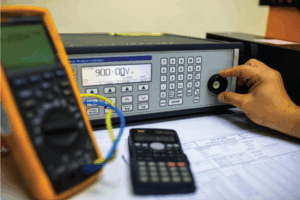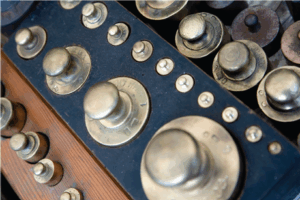To read this article in Spanish, click here.

A2LA accredits various laboratories and other organizations such as reference material producers, proficiency testing providers, inspection bodies, biobanks, and product certification bodies. A2LA is the largest accreditor of calibration laboratories in the United States, with over 800 organizations accredited. These calibration laboratories support many of our other accredited organizations and other accredited calibration laboratories. Regardless of the area of accreditation, improved communication between accredited organizations and calibration providers is needed.
First, let’s describe a typical scenario of what happens when a lack of communication and responsibility for the calibration service provided occurs:
- A laboratory ships an instrument to their calibration vendor with a purchase order that only states “calibrate per ISO/ IEC 17025”. The equipment owner assumes the calibration vendor knows what calibration is needed with that bit of detail as they are the calibration expert, after all.
- The calibration vendor receives the order and contacts the laboratory that owns the equipment to obtain specific information on the service needed. The shipping clerk at the laboratory answers the call from the calibration vendor, doesn’t know how to answer their questions, and tells the calibration vendor to “just do what’s best.” Being in a hurry to complete the calibration because it is a rush order, the calibration vendor defaults to their “standard” level of service.
- The laboratory receives the calibrated instrument back from its vendor, performs a cursory check to ensure that the device turns on and that the paperwork was included in the box, and places the instrument back into the laboratory for use.
- Later, when a third-party assessor comes onsite for the assessment. The laboratory receives two deficiencies regarding traceability. One is because they only completed a limited calibration (where only a portion of the specification was evaluated) on the instrument. Secondly, the calibration certificate is missing the accrediting body’s (AB’s) endorsement symbol and the laboratory’s accreditation certificate number. When filling out the “root cause” information in the corrective action form, the quality manager for the laboratory writes, “the calibration vendor provided the wrong service from what was needed.”
What went wrong here?
A simple answer is a communication breakdown between the laboratory and the calibration vendor. Let’s take a moment to address potential issues that cause these problems in communication.
We aren’t speaking the same language
One of the most critical factors of effective communication is ensuring that we are speaking the same language and that everyone can understand one another. However, the calibration vendor will generally be a metrologist, and they will speak the language of metrology. Laboratories reaching out to a calibration vendor might not speak metrology as they rely on the calibration vendor to speak and understand that language. This language barrier creates an immediate problem as the laboratory and the calibration vendor can’t communicate effectively from initial contact.
It isn’t just the laboratories fault. The calibration vendor has to recognize that language is an issue, and they have to be able to interpret their metrology speak into a common language that their customer can understand. Communication is a two-way street, and both parties have to ensure they understand each other.
Think of taking your car to the mechanic for routine maintenance. The mechanic speaks a different language than most customers who walk through that door. The mechanic might start rattling off technical terms and car parts that sound alien, and you have no idea how to translate them into your language. You want the mechanic to fix your car so you can keep driving. Well, the mechanic should understand how your vehicle is performing and how you use your vehicle so they can perform the appropriate maintenance and repairs.
Poor communication on either side of the conversation can cause them to perform the wrong or unnecessary services on the car. I don’t know many times the blinker fluid got changed or the Flux Capacitor flushed in my car before I realized that wasn’t even a thing!
The laboratory and the calibration vendor must take the time to ensure that the appropriate information is conveyed before proceeding with the calibration service, but done, so everyone understands what needs accomplishing.
It’s all about perspective
 Essentially the laboratory and the calibration vendor understand that they have pretty different perspectives when they approach the interaction for requesting calibration service. The way a laboratory looks at a balance is probably a lot different than a calibration vendor looks at a balance.
Essentially the laboratory and the calibration vendor understand that they have pretty different perspectives when they approach the interaction for requesting calibration service. The way a laboratory looks at a balance is probably a lot different than a calibration vendor looks at a balance.
They both see it as a device that is capable of measuring mass. Still, the laboratory uses that balance as a tool to perform their work, and the calibration vendor views that balance as the item under test, and the balance is their work. The laboratory knows precisely how they use that balance in their laboratory. The calibration vendor must assume that the balances use is as a typical one used in various laboratories. Also, the laboratory may not be very familiar with how that balance operates, and the balance may not be a critical part of their measurement process. However, the calibration vendor is the expert and understands how that balance works. The scientific principles behind the associated measurements and the balance are critical parts of their measurement process. And don’t forget that to the laboratory calibration service is an expense, and to the calibration provider, it is a source of revenue.
It’s important to remember the different perspectives when communicating to ensure that each party understands one another and appreciates the unique views.
We’ve talked about some potential reasons for communication breakdowns that lead to problems when requesting calibration service. However, it is essential to remember that there is a lot of common ground that most laboratories and calibration vendors have generally found in the requirements of ISO/IEC 17025 and Accreditation Body requirements.
The ISO/IEC 17025 standard has requirements for Contract Review (Section 7.1), Externally Provided Products and Services (6.6), and Reporting the Results (7.8) that all address the interactions between laboratories and their calibration vendors. All those requirements boil down to ensuring appropriate laboratory and calibration vendor communication. Ensuring the laboratory ordered what was needed and the calibration vendor-provided what was requested.
It is also important to remember that the laboratory and the calibration provider are really in the same business of providing reliable data to their customer. Both parties want to ensure that their customer is receiving the best and most reliable data to their customers and in doing that, all parties have to ensure that they understand their customer’s needs. A better understanding of their customers’ needs and better communication throughout the calibration service process lead to improved results.
When both parties understand the requirements for purchasing and receiving calibration services, properly communicate their needs, and take more responsibility for the service provided, many of the misunderstandings during this process get avoided.
Take the first step in building quality and confidence in your organization. Click here to request an estimate. For more information about accreditation, contact A2LA at info@A2LA.org or call 301-644-3248.
